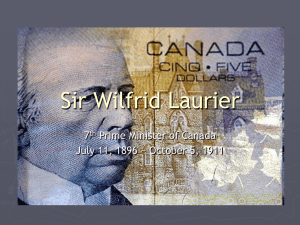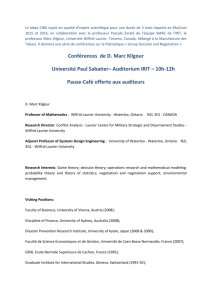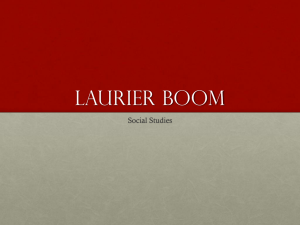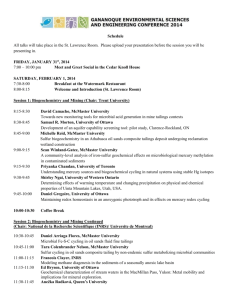Analytical Chemistry I B1. Q test B2. Q table B3. Q example
advertisement
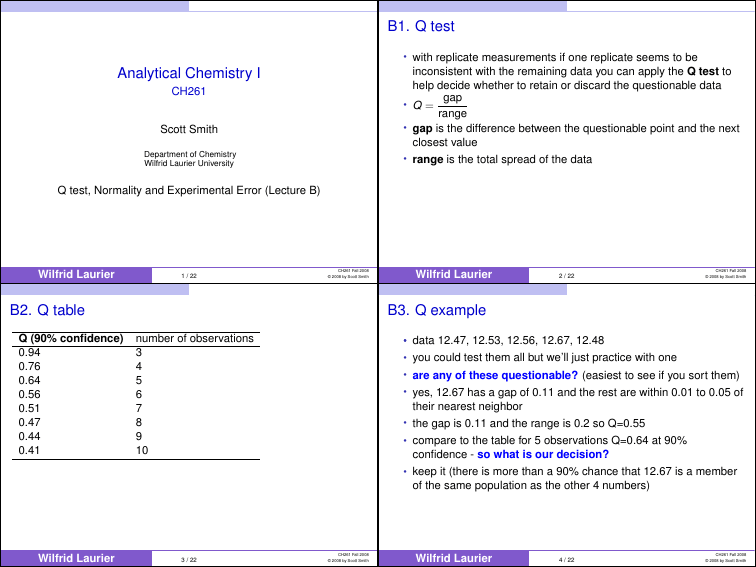
B1. Q test • with replicate measurements if one replicate seems to be Analytical Chemistry I inconsistent with the remaining data you can apply the Q test to help decide whether to retain or discard the questionable data gap • Q= range • gap is the difference between the questionable point and the next closest value CH261 Scott Smith Department of Chemistry Wilfrid Laurier University • range is the total spread of the data Q test, Normality and Experimental Error (Lecture B) Wilfrid Laurier 1 / 22 CH261 Fall 2008 © 2008 by Scott Smith B2. Q table Q (90% confidence) 0.94 0.76 0.64 0.56 0.51 0.47 0.44 0.41 Wilfrid Laurier 2 / 22 CH261 Fall 2008 © 2008 by Scott Smith B3. Q example number of observations 3 4 5 6 7 8 9 10 • data 12.47, 12.53, 12.56, 12.67, 12.48 • you could test them all but we’ll just practice with one • are any of these questionable? (easiest to see if you sort them) • yes, 12.67 has a gap of 0.11 and the rest are within 0.01 to 0.05 of their nearest neighbor • the gap is 0.11 and the range is 0.2 so Q=0.55 • compare to the table for 5 observations Q=0.64 at 90% confidence - so what is our decision? • keep it (there is more than a 90% chance that 12.67 is a member of the same population as the other 4 numbers) Wilfrid Laurier 3 / 22 CH261 Fall 2008 © 2008 by Scott Smith Wilfrid Laurier 4 / 22 CH261 Fall 2008 © 2008 by Scott Smith B5. •Error B4. Normality • Normality is a concentration unit that takes reaction stoichiometry into effect • if reaction stoichiometry is 1:1 then normality is the same as molality • if you change the reaction the reagent (titrant) is used for its normality changes • for proton donation reactions, normality of 1 M HCl and 1 M H2 SO4 ? • for redox reactions normality is determined by the number of electrons transfered • normality is defined in appendix E of Harris. Figure: There are errors associated with every measurement Wilfrid Laurier 5 / 22 CH261 Fall 2008 © 2008 by Scott Smith Wilfrid Laurier 6 / 22 CH261 Fall 2008 © 2008 by Scott Smith B7. •Practice B6. Significant Figures • The number of significant figures is the minimum number of digits needed to write a given value in scientific notation without loss of accuracy • leading zeros are not significant • last digit (at least) has uncertainty • some numbers have no uncertainty - can you think of an example? • how many significant figures is 107400 ? • try to estimate to the nearest tenth of a division Figure: linear and logarithmic scales Wilfrid Laurier 7 / 22 CH261 Fall 2008 © 2008 by Scott Smith Wilfrid Laurier 8 / 22 CH261 Fall 2008 © 2008 by Scott Smith B8. Sig Fig Arithmetic B9. Rounding • round on the final answer to avoid acculation of round-off errors • example 1: 121.7943 = to 3 decimals • (1) if the numbers being added or subtracted have equal number • example 2: 43.55 = to 3 sig figs of digits the answer goes to the same decimal place as the individual numbers • round to nearest even digit when last digit is a “5” • example 3: 43.25 = to 3 sig figs • this can lead to an increase or decrease in significant figures • example 4: 43.2500001 = to 3 sig figs • example 1: 5.345 + 6.728 = • example 2: 7.26 × 1014 − 6.69 × 1014 = • (2) if the numbers do not have equal numbers of digits the answer is limited to the by the least certain one • example 3: 18.9984032 + 18.9984032 + 83.798 = Wilfrid Laurier CH261 Fall 2008 9 / 22 © 2008 by Scott Smith B10. Sig. Figs in × and ÷ digits contained in the number with the fewest significant figures • example 1: (4.3179 × 10 / 22 CH261 Fall 2008 © 2008 by Scott Smith B11. Logarithms • (3) in multiplication and division answer is limited to the number of 1012 )(3.6 Wilfrid Laurier × 10−19 ) =answer • power of 10 has no influence on the number of figures retained • a logarithm is composed of a characteristic and a mantissa • chacteristic is the integer part and the mantissa is the decimal part • (4) the number of digits in the mantissa of a number should equal the number of significant figures in that number • example 1: characteristic and mantissa for log 339answer • example 2: characteristic and mantissa for log(3.39e − 5)answer • (5) the number of sig figs in the antilogarithm should equal the number of digits in the mantissa • example 3: 10−3.42 =answer Wilfrid Laurier 11 / 22 CH261 Fall 2008 © 2008 by Scott Smith Wilfrid Laurier 12 / 22 CH261 Fall 2008 © 2008 by Scott Smith B12.• Sig fig graphing B13. Sig fig graphing Figure: showing trends Wilfrid Laurier 13 / 22 Figure: meant to display quantitive behaviour CH261 Fall 2008 © 2008 by Scott Smith Wilfrid Laurier 14 / 22 CH261 Fall 2008 © 2008 by Scott Smith B15.• Accuracy B14. Systematic Error • errors arising from flaw in the equipment or experimental design are systematic errors • these errors are reproducible and will lead to answers always too high or too low (on or the other) • can you think of some examples ? • systematic errors can be indentifed and controlled • random error may be positive or negative and cannot be removed (but can possibly be minimized) • can you think of some examples ? • precision and accuracy are important concepts Figure: before and after introduction of SRM Wilfrid Laurier 15 / 22 CH261 Fall 2008 © 2008 by Scott Smith Wilfrid Laurier 16 / 22 CH261 Fall 2008 © 2008 by Scott Smith B16. Propagation of Uncertainty B17. Propagation of Uncertainty • for addition and subtraction the error is the square root of the • for multiplication and division the error is the square root of • for errors q e1 , e2 and e3 for an arithmatic operation we can write • for errors %e q1 , %e2 and %e3 for a × or ÷ operation we can write • example 1: (1.76 ± 0.03) + (1.89 ± 0.02) − (0.59 ± 0.02) =answer (1.76 ± 0.03)(1.89 ± 0.02) • example 1: =answer (0.59 ± 0.02) the sum of squares of the absolute uncertainities eoverall = e12 + e22 + e32 • example 2: what is the percent relative uncertainty in example the the sum of squares of the percent relative uncertainities %eoverall = %e12 + %e22 + %e32 1answer Wilfrid Laurier 17 / 22 CH261 Fall 2008 © 2008 by Scott Smith Wilfrid Laurier 18 / 22 CH261 Fall 2008 © 2008 by Scott Smith B19.• Propagation of Uncertainty B18. The Real Rule for Sig figs • the first digit of the absolute uncertainty is the last significant digit in the answer (0.002364 ± 0.000003) =answer (0.02500 ± 0.00005) • example 1: Figure: Propagation of uncertainty rules Wilfrid Laurier 19 / 22 CH261 Fall 2008 © 2008 by Scott Smith Wilfrid Laurier 20 / 22 CH261 Fall 2008 © 2008 by Scott Smith B20. Systematic Uncertainty B21. Practice • for systematic uncertainty arithmetic just add the uncertainties • on tests I’ll give you table 3.1 (remind me!) • this is because the uncertainties are not random • the only good way to learn this stuff is practice and lots of it • example 1: if a pipette delivers 25.00 ± 0.03 and you use it to • all the problems in the chapter are good but the last few 3-19 to deliver 100 mL, what is the uncertainty? 3-23 are a little trickier • if the pipette is calibrated 24.991 ± 0.006 mL what is the uncertainty ? • 99.964 ± 0.012 Wilfrid Laurier 21 / 22 CH261 Fall 2008 © 2008 by Scott Smith Wilfrid Laurier 22 / 22 CH261 Fall 2008 © 2008 by Scott Smith

